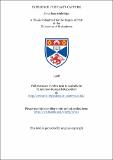Files in this item
Inference for plant-capture
Item metadata
| dc.contributor.advisor | Goudie, Ian B.J. | |
| dc.contributor.author | Ashbridge, Jonathan | |
| dc.coverage.spatial | 173 p. | en_US |
| dc.date.accessioned | 2018-06-05T15:43:27Z | |
| dc.date.available | 2018-06-05T15:43:27Z | |
| dc.date.issued | 1998 | |
| dc.identifier.uri | https://hdl.handle.net/10023/13741 | |
| dc.description.abstract | When investigating the dynamics of an animal population, a primary objective is to obtain reasonable estimates of abundance or population size. This thesis concentrates on the problem of obtaining point estimates of abundance from capture-recapture data and on how such estimation can be improved by using the method of plant-capture. Plant-capture constitutes a natural generalisation of capture-recapture. In a plant-capture study a pre-marked population of known size is added to the target population of unknown size. The capture-recapture experiment is then carried out on the augmented population. Chapter 1 considers the addition of planted individuals to target populations which behave according to the standard capture-recapture model M₀. Chapter 2 investigates an analogous model based on sampling in continuous time. In each of these chapters, distributional results are derived under the assumption that the behaviour of the plants is indistinguishable from that of members of the target population. Maximum likelihood estimators and other new estimators are proposed for each model. The results suggest that the use of plants is beneficial, and furthermore that the new estimators perform more satisfactorily than the maximum likelihood estimators. Chapter 3 introduces, initially in the absence of plants, a new class of estimators, described as coverage adjusted estimators, for the standard capture-recapture model M[sub]h. These new estimators are shown, through simulation and real life data, to compare favourably with estimators that have previously been proposed. Plant-capture versions of these new estimators are then derived and the usefulness of the plants is demonstrated through simulation. Chapter 4 describes how the approach taken in chapter 3 can be modified to produce a new estimator for the analogous continuous time model. This estimator is then shown through simulation to be preferable to estimators that have previously been proposed. | en_US |
| dc.language.iso | en | en_US |
| dc.publisher | University of St Andrews | en |
| dc.subject.lcc | QA276.6A8 | |
| dc.subject.lcsh | Sampling (statistics) | en |
| dc.title | Inference for plant-capture | en_US |
| dc.type | Thesis | en_US |
| dc.contributor.sponsor | Engineering and Physical Sciences Research Council (EPSRC) | en_US |
| dc.type.qualificationlevel | Doctoral | en_US |
| dc.type.qualificationname | PhD Doctor of Philosophy | en_US |
| dc.publisher.institution | The University of St Andrews | en_US |
This item appears in the following Collection(s)
Items in the St Andrews Research Repository are protected by copyright, with all rights reserved, unless otherwise indicated.

